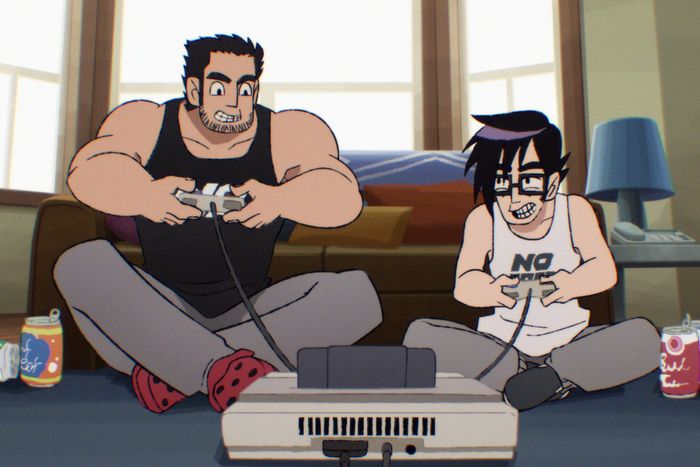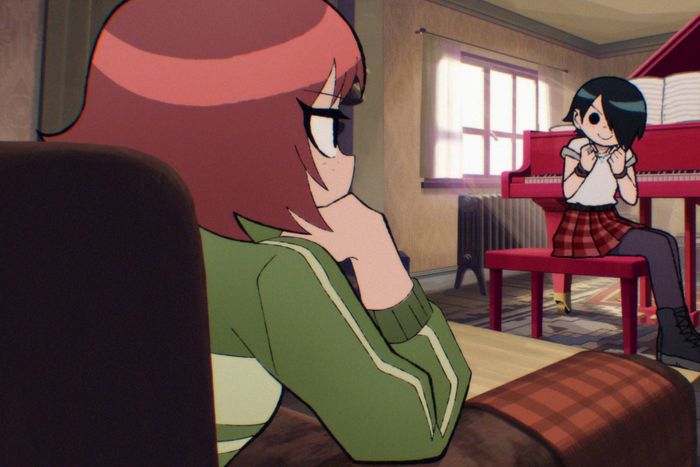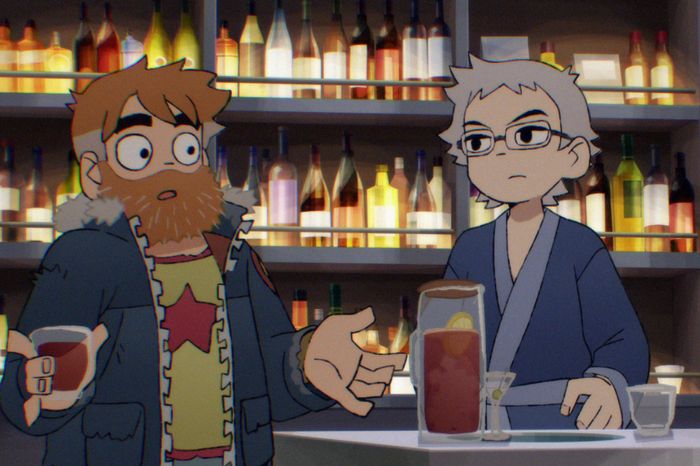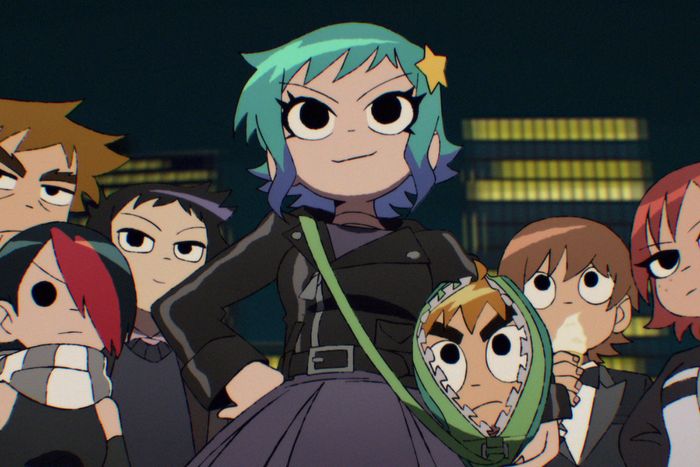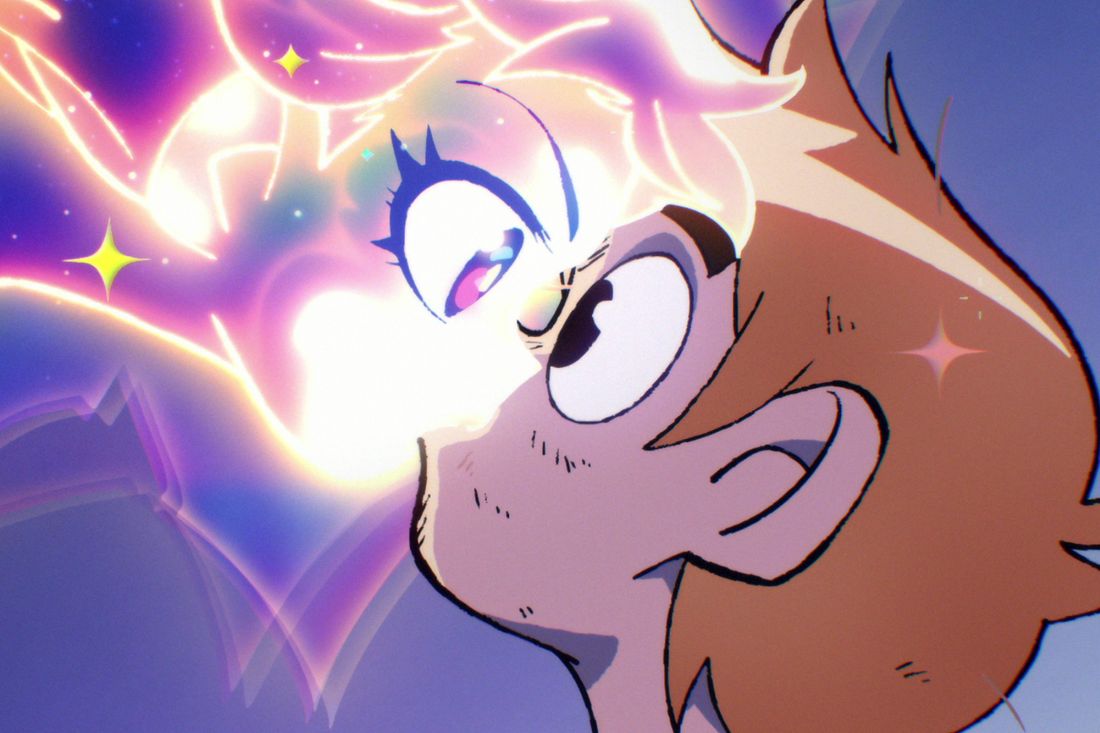
Spoilers follow for the entirety of Scott Pilgrim Takes Off.
It was BenDavid Grabinski who proposed the murder. He and Bryan Lee O’Malley had gotten together one night a few years ago to screen his new film at the time, Happily, when O’Malley brought up that Netflix had approached him to adapt his beloved Scott Pilgrim graphic novels, about a 20-something Torontonian who finds himself having to fight seven evil exes in order to be with the girl of his dreams, into an anime series. O’Malley was struggling with the ask, uncertain what to do with the prospect of revisiting a story he’d last worked on over a decade ago. That’s when the idea came flying out of Grabinski’s mouth, according to O’Malley: “He was like, Well, what if Matthew Patel just kills Scott Pilgrim?”
“I believe the sentence was closer to, ‘What if, at the end of the pilot, Scott loses to Matthew Patel, and then what if there’s a movie of Scott Pilgrim in the show starring Lucas Lee?’” clarifies Grabinski. Everything else came later, but it was that one sentence, containing two bullet points, that set the entire creative enterprise into motion. “That was the spark of it,” says O’Malley. “To start out normally, then suddenly diverge into a big ‘What if?’ and do whatever we wanted right after that.”
Of course, Scott doesn’t actually die in this adaptation, which came out last week. But he does stay gone for much of the season, and Scott Pilgrim Takes Off presses forward by wrapping itself around Ramona, who, in the absence of Scott, sets off to confront her seven evil exes, and her past, by herself. Rendered beautifully by Science SARU, the anime offers a more meditative take on the fantastical universe of Scott Pilgrim, building upon nearly two decades’ worth of feeling around the original graphic novels to create something entirely new while, O’Malley and Grabinski believe, functioning as a solid introduction for those encountering these characters for the first time.
All that only becomes apparent, though, at the end of the first episode, which for the most part carries itself as a beat-by-beat re-creation of the original story. To Grabinski and O’Malley, constructing the anime’s opening as a bait and switch is crucial to their intended effect. “It’s designed to show you what you may realize you didn’t want,” says Grabinski.
This interview has been edited and condensed for clarity.
Was there ever any concern whether viewers might turn off the first episode before the break becomes apparent?
BenDavid Grabinski: No. We’re fine with someone being upset because they turned it off and someone else spoils it for them. It just felt, organically, that was the only way to do it that made sense for the story because you need to spend time with these people before the digression happens. You can’t rush it.
Bryan Lee O’Malley: It wouldn’t be Scott Pilgrim. When you read the first book for the first time, you get like 120 pages of slice-of-life stuff before you find out Scott is this great fighter — before all the Marvel vs. Capcom, Street Fighter stuff happens. Doing the show was a microcosm of that structure. We go “normal, normal, normal, crazy.”
Grabinski: We had to make a whole brand-new crazy because everything Bryan did in the book, and that was done in the movie, has been normalized. It’s not shocking anymore to learn that this young 20-something love story has video-game fights. How do we push that concept even further?
When did Netflix approach you to do this adaptation with Science SARU?
O’Malley: It was around late 2018, early 2019. It was definitely after Devilman Crybaby had come out, which was such a watershed moment in terms of anime and remakes. I knew studio co-founder Masaaki Yuasa from way back. His first movie, Mind Game, came out the same year as the first book of Scott Pilgrim. So it was automatically appealing to work with them. It was just a matter of “Why?” Why now? What does Scott Pilgrim have to say today?
Grabinski: To us, the idea of doing a Scott Pilgrim with Science SARU was the most exciting thing in the world, but you don’t want them to just be a cover band. They could do an amazing version of the books, but why don’t we try to tell a new story that’s shocking and emotional and funny instead of getting all these genius people to just try to re-create beat-for-beat something that already works?
O’Malley: And the comic is not a manga. It’s not done with the kind of pacing and reliance on action that manga is known for, which is what anime generally grows out of. So it didn’t really make sense to try to get them to adapt this thing beat-for-beat when the beats are intentionally mundane and down to earth. They’re very plain in a lot of ways. It was more appealing when we started coming up with new action scenes, new ways in, and new things to look at.
Let’s talk about that new stuff. The anime mostly swaps out Scott for the bulk of the season and repositions Ramona as the new protagonist for the narrative. It’s not just her story, of course, because her evil exes also get their own arc and closure. Other characters like Knives do as well. What drove your interest in expanding the frame beyond Scott?
Grabinski: In the books, Scott having to fight a bunch of evil exes is a really great idea for a story. But our thinking was if you remove that thread, what happens to these people? How would they achieve closure? How do they grow up when they’re not just in orbit of Scott’s narrative? How is Ramona going to deal with them now that they’re not getting murdered by her boyfriend? And if the exes don’t fight Scott, who do they become as people? What’s going to happen to the league?
I’ve always viewed Scott Pilgrim as an ensemble, and I love almost all the characters equally. I mean there’s probably a couple I like more than others. Someone like Lucas Lee, especially in the movie version and our show version — he embodies everything I love about stuff. But having everything being in orbit of Scott fighting the exes kinda limits your opportunities for a lot of these people. It felt really dramatic to us to have Ramona have to be alone with these people, and to deal with their past, and for them to deal with their past with her.
O’Malley: If you take Scott out, what then are all these people so mad about? What are the alternate forms of conflict resolution that we can use to learn more about them? That villain scene in the first episode was my first North Star for the show. I just wanted to have more villain scenes, ’cuz anime is so good at villain scenes. A lot of this just sort of grew naturally from wanting to do that.
Grabinski: When we were cracking the story, we were also thinking about things we love about anime, and if those things could ever dovetail with each other. Bryan and I love when, in the pilot of an anime, you cut to a dark, shadowy place and you find an evil guy on a throne — he’s in a cave or a high rise or something. There are tropes that make us so happy, and if we could find ways to use those while also servicing this version of the story, that would just be extra. So we were always kind of thinking about both of those things simultaneously, but we didn’t put anything in there unless it really kind of fed into the story we were trying to tell.
O’Malley: Right. We got to write this huge scene where all the exes come together, and you got to have Chris Evans interacting with Jason Schwartzman and stuff, but we didn’t do it for that. We did it because it was part of the story.
Beyond those tropes, what did adapting Scott Pilgrim as an anime unlock for you creatively?
O’Malley: I’d say two things, and they’re both a form of weightlessness. There’s weightlessness physically in the sense that, like, in The Matrix they had to use wires and special cameras to achieve an effect, but in anime you can just draw it out. They can fly. They can do whatever they want. And then there’s weightlessness in terms of character. Scott is kind of a heel, as we know, but if he’s drawn, there’s something innocent about him that balances it out. If he’s a real human, some people probably won’t tolerate his activities. As a drawing, there’s a safe space to explore his … uh, personality quirks, let’s call them.
Grabinski: It’s a balance of really heightened and really grounded elements at the same time. Hopefully by the time people get to episode three, they’ll realize the show is more emotional than they were expecting. You might think everybody’s always gonna be at a ten out of ten. Every scene is just gonna be for maximum velocity or maximum jokes, but then we suddenly pull it back.
I’m not trying to throw shade here, but when they made the live Cowboy Bebop adaptation, it felt like people were too eager to do the big pop-action goofy stuff. But they don’t realize there’s so much quiet stillness to everything. It borders on a Jarmusch indie. The thing about anime that’s really beautiful is that we can go really big and really small. It feels of a piece. It also helps build into how unexpected we wanted the story to be. A lot of our story instincts really work for the format.
That stillness tracks. The scene I responded to the most was the jam session between Kim and Knives, which had that quality of being a really big and a really small moment. To me, it also underscored the adaptation as being linked, in some ways, to the kind of meditativeness that comes with growing older. Tell me about that scene.
O’Malley: I wanted to write stuff I could never write in a comic book. Obviously, that scene is all about sound. Not dialogue, not really action. They’re just playing instruments. But it’s so emotional. It really works after we put it all together. I love being able to do that.
In terms of getting older and stuff — yeah, totally. We were making the show mid-COVID. My mom passed away a few years ago, after the show was pitched to me but before we got started. I was processing a lot of stuff. We’re all losing people and getting older, and it just felt right to work that in, because it feels like the world we all live in, whether we like it or not.
Grabinski: That’s my favorite scene of the season. I think having empathy for people doing dumb stuff in their 20s is a bit more surprising and also satisfying because you can look back at your 20s when you’re older and feel nothing but embarrassment, which is really how most people do feel and I do feel. But I think if you could find some little bit of grace and just try to cut them a little slack, it’s a really good counterbalance to all the sarcasm and weird energy.
We were trying to find something that was more complicated and nuanced. That’s the kind of thing you can only do when there’s a bunch of adaptations already, and there’s been so many years of perspective and life experience that you can just say, “Okay, this time we’re going to try to make things a little bit more complicated emotionally or tonally.” We’re just building on top of all this other work. In all of our conversations creatively, there’s always a subtext of who we are now versus Bryan making these things when he was the age of the characters.
And that gets refracted somewhat literally in the last two episodes with Old Scott coming into the picture.
O’Malley: Those last two episodes are some of my favorite stuff I’ve ever got to work on. I’m very happy with them. You get to a certain point that you have to start looking forward and cringing, otherwise you’re going to become that.
A lot of people like to say Scott Pilgrim’s the bad guy of his own story, or he’s the worst character, or he’s the eighth evil ex. And that’s a totally valid interpretation — that’s definitely present in the original material. So it was fun to lean into that in a comedic and pathos-driven way. I’m really happy with how the older Scott evolves from episode seven to episode eight. The way they brought that element alive where it does feel like this could be the Old Scott from that we know from the original versions of the story. Now we have this new, tiny bit more enlightened version of Scott who can look at this and cringe.
Grabinski: I really like that we leave it where you don’t know who Scott and Ramona are going to become. But they both have even more to learn from now. They have this other version of themselves to learn from. They have this time without each other to learn from.
I can’t talk about Old Scott without bringing up Will Forte, because they’re one and the same. We wanted to do that character and have him not be the same actor as Michael, and Will was the only choice that we wanted. It’s the same with anything, whether it’s casting or the music: Any idea that we have on a story level, there’s also kind of a functional thing that you need in order for it to work. That character needed the right actor or else he’d be annoying as hell or just unlikable.
Will has a thing where he’s kind of a puppy dog even when he’s playing someone who’s very flawed and maybe deranged. He has an innocence to him even when he’s just bluster or is doing really dumb stuff. It’s endearing. He needs to be a silly idiot at times. He’s the fucking best. MacGruber’s my favorite comedy of all time. Bryan and I both love it dearly.
O’Malley: I just want to add that, in the Japanese version, Old Scott is played by Fumihiko Tachiki, who played Gendo Ikari in Evangelion, which adds this whole other layer to it. One of the greatest, most complicated villain performances of all time. He does the Will Forte pathetic stuff that’s so funny too.
Grabinski: It adds another fun level because the A.K. Fields are a homage to the A.T. Fields from Evangelion, so to have that actor doing that is unreal. I’m a huge, huge, huge fan of that show and the Rebuilds. But we can’t take any credit for it. We had no idea he was playing him until we hit play and heard it. That was all Science SARU.
I’m glad you brought up Rebuild of Evangelion, because Takes Off does remind me of that particular approach toward adaptation where it starts out as a modern re-creation before swerving to become a conversation with the original text. To what extent were you designing this story with the assumption that viewers are coming into it with a strong relationship with previous Scott Pilgrim iterations, and to what extent were you assuming no relationship at all?
O’Malley: That was the biggest challenge. Because we know that exists, right? That whole scaffolding above Scott Pilgrim: the history, the fandom, the debates, the takes. It’s all part of the mix now, and you can’t really ignore that. At the same time, you have to make a show for someone who’s just turned on Netflix and sees the tile and is like, “Oh, I’ll check this out.” It’s a hard line to walk.
Scott Pilgrim has been popular for almost two decades now, and because of that it has perhaps grown beyond a sense of whatever ownership you might’ve felt over it. What is your relationship to Scott at this point, and does this project represent some kind of reassertion of authorship?
O’Malley: I don’t know if it’s ownership, but I definitely wanted to reclaim something. I wanted the upper hand in some regard. I think it was more the element of surprise. People were surprised when they read the book, and that’s hopefully part of why they liked the book in the first place. I wanted to throw them off guard a little bit. I want it to be a little dangerous. They don’t know what could happen next. Anybody could die now, you know? That was really fun to me.
Grabinski: Knowing Bryan, and knowing how I felt making this, it’s less reclaiming ownership than expanding something. We just took something we both loved and made it feel bigger and more complicated.
O’Malley: Yeah, it’s like Scott Pilgrim had a little circle and then we drew a much bigger circle around it.
I read that the show was green-lit without a cast. Is that true?
Grabinski: Oh yeah. I don’t think anyone would ever admit it out loud, but I doubt anyone thought we would actually get the cast. That was just a big leap of faith. We had no idea what they would say. We all normalize things in revisionist history, but I’m pretty sure I went to bed most nights thinking we weren’t going to get the actors. It only feels normal now because it exists, and they’re in the show, but it’s still really confusing to me. It doesn’t make any sense that they all said yes, and that they all were excited about this really new, weird version of the story.
O’Malley: I have to constantly reiterate that it’s not one miracle, but like 15 miracles to make the show happen the way it did. People might take it for granted, but it was not for granted when we were making the show.
Grabinski: We bought 16 lottery tickets, and all of them had to win. We were trying to do our own thing, but getting new actors for these parts could really be a fool’s errand because they were so well cast and you run the risk of people thinking you’re just looking for sound-alikes. Every performance you’re like, “Is this as good?” And suddenly you’re adding things to your viewing experience that are unnecessary.
How did they all say yes? Was it an Edgar Wright thing? Was it a Netflix thing?
O’ Malley: It’s pretty much an Edgar thing. Edgar wrote a really nice letter, and we had talked about it with them off the cuff here and there. “Maybe we’ll do something animated,” and they’d be like, “Cool, sure, we’d love to.” But you never really know what they’re going to say.
Then one day in June last year, Edgar sent a nice email out. Me and BenDavid wrote a nice note to go along with it. We sent them the first two scripts, crossing our fingers. I remember BenDavid was lying on my couch, and we just started getting emails back probably within the hour. I’m not going to specify anything less than an hour, but within an hour we got at least two emails from major actors saying, like, “Sure, I’ll do it.”
We were over the moon. So the rest of the day we were not working very much. We were just waiting for more emails. By lunchtime, most of the people had said “yes.” And we started our day late.
Grabinski: There are so many things you have to do to make a show or movie work that are out of your control. And the one thing that really worked in our favor is that they all had such a good time making that movie. So much of it was dependent upon the fact that all those people had such a good time making that movie in Toronto forever ago.
I’m glad that we worked really hard on the story to give them something worth doing, so it isn’t just them showing up and having to repeat themselves. They love the characters and feel some ownership over them, and we gave them an opportunity to expand on them. If we had just done an adaptation, it would have felt more like it was just math when they were on it. It just felt like we were in a room jamming and figuring out the most interesting way to do things.
I’m curious: What are your relationships with growing older?
Grabinski: I can’t pretend to know what it’s like to be 23 in 2023. But the combination of our memories from that time period, our love of these characters, and our life experiences can only infuse more interesting takes on that era. I wanted to make something about younger people for younger people but with some subtext and weight about what it feels like to be older and alive and how we look back on it. And all without having that get in the way of telling a story for younger people, you know: I didn’t want to make it where Older Scott is the hero and he knows everything and young people don’t. But this isn’t a story that I could have told in my 20s.
For me, the stuff I write that I’m the most proud of is just from being in the shit of being alive for a long time and having that infuse the story. As I get older, I try to make stuff that, while maybe being glib or funny or ironic or whatever, there’s more melancholy or humanity in there but without getting too sentimental.
O’Malley: I’ve always thought the reason the books make sense and has stayed around for young people is … you know, I wrote them from age 25 to 30 and then it’s like I went off and came back and told you what it was like to go through those years. Now it’s like I went further down the line and came back to tell you when you’re 18, 19, whatever the target audience is, “Here’s what it’s like to be that much older.” It’s not all pretty. But we can have fun with it.
Bands and comics and anime — they’re always going to be kind of teens, late-teens stuff. That’s the age to experience that stuff for the first time and to be excited about it. So, of course, I want to corral all of us in. Us older kids too. We deserve a fun show with layers for us. But if you’re 18, you can turn it on and just be like, “Shit, these guys have seen some stuff.”
A lot of the stuff you celebrate in Scott Pilgrim — manga, anime, video games, indie music, even Toronto — they’ve all become mainstream cool these days. I’m wondering how you feel about that.
O’Malley: I’m less inclined to do tons of references now. Because (a) I’ve already done them in the movie, in the books, and (b) they’re so normalized now. When I drew Scott Pilgrim flying with a raccoon tail in 2005, no one had really done that before. Now every single person on the internet has drawn their character with a raccoon tail from Super Mario Bros. It just doesn’t hit the same, as the kids would say. We found some new references, but for the most part, we’ve built our own world. You can reference it, but it’s not referencing anything else all the time.
Grabinski: I do have to admit it just gave me the license to go way weirder because so much of this stuff has been so normalized. So I’m like, “All right, well, now we can have a scene that references Akira and Minions and all these things in the span of 20 seconds.” This is the world we live in now. You guys are fucked. You’re gonna have to have a character quote Southland Tales because it’s so normal that people played Mario Bros., you know?
My goal for all of it, though, is that you don’t have to know a single reference in the show for it to work. I mean, everyone’s gonna get the DeLorean thing, but besides that, I think references just mean less now. There’s a ton of them that mean a lot to us, but I don’t think you need them for the show to work.
O’Malley: It’s just an ongoing tapestry of everything we’ve ever loved, and we’re sharing it with the people.




